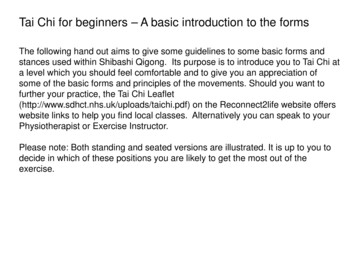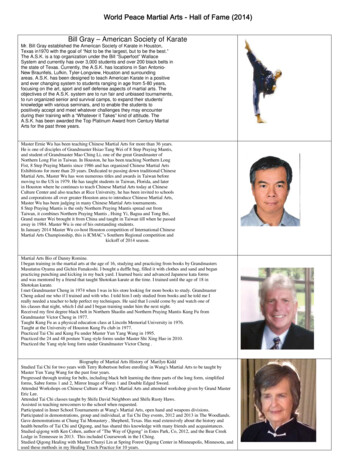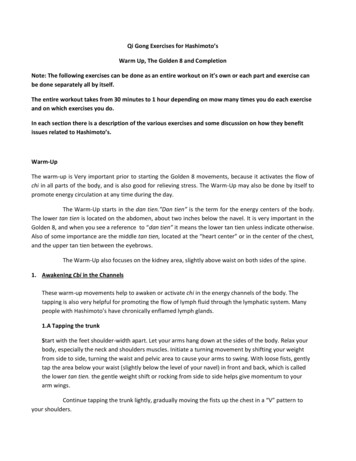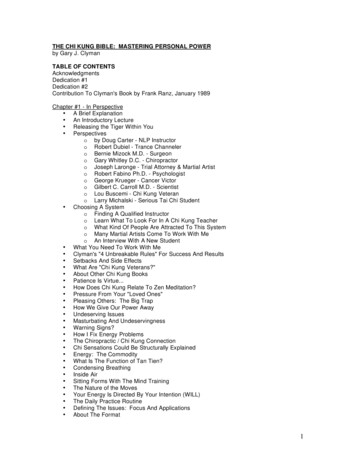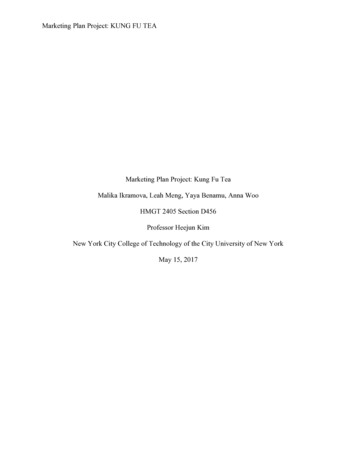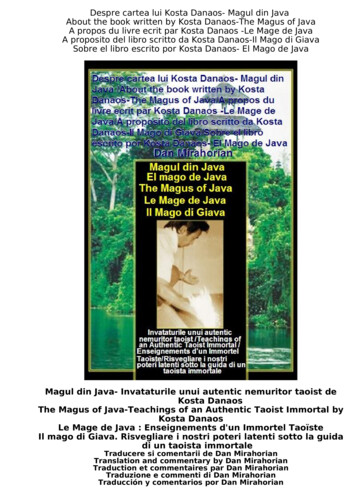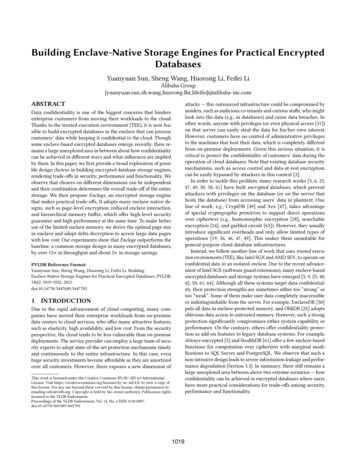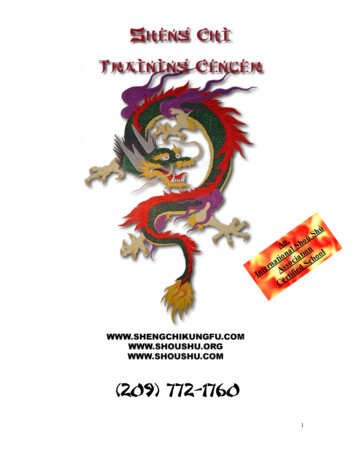
Transcription
húSúoAn l Sh naloon iati hooitna s s oc d ScretA ifieInrtCe(209) 772-17601
What is Shou' Shu?Shou' Shu, meaning “fighting way of the beasts”, wasbrought to us by Da' Shifu Al Moore Sr. It is anancient form of Kung Fu whose motions are basedupon the fighting ways of seven different animals.These are the bear, siberian tiger, mongoose, whitecrane, praying mantis, cobra, and the imperialdragon. Each of these animals represents a distinctfighting system in itself and when they are combinedit is called Shou’ Shu'.In the world of martial arts there are very few truefighting arts left. Fighting arts are defined as arts that,at their core, still retain the pure intent of selfprotection. While it may not be obvious to thelayman, most so called martial arts are not trulymartial at their core. They are certainly founded uponmartial principle but have deviated for some otherpurpose.These purposes can be but are not limited to: Government controlConversion to a sportCommercialismThese three influences have changed the martial arts world to something completelydifferent than what it was. Because of this change the publics perception of what martialarts are and how their training methods operate has also been greatly altered.Shou' Shu' is one of the rare fighting arts that has been preserved. It has not deviated fromit's original intent. Some things may change as modern influences change. But as long asthe intent and the principle remains true, then the art is considered to be pure. There arestill a few schools and individuals teaching the art in this pure form.One of my favorite quotes from Da' Shifu Al Moore Sr. was"There is no your way. There is no my way. There is only the Shou' Shu' way"What this meant was that to be true it had to follow principle. Personal opinion cannot beinvolved. There are three tests which can be applied. If all three are true it is Shou' Shu'.If not, it is not. these are:1) Constant flowing focused chi2) Immediate control of opponents centerline3) Block possibilities rather than weapons2
The development of Shou' Shu' can be accredited to the Mandarins. This is why we stillcall it Chinese martial arts even though it is no longer practiced in China. As with mostmartial arts it originally came from ancient Egypt. It was brought to India and eventuallypassed on to the Chinese. In China it was developed to an extremely high level ofsophistication by the Mandarin warlords. The art was kept within the royal families byonly teaching it to the eldest son of a Mandarin warlord. In this way the secrets of the artwere protected.As you study Shou’ Shu' you will slowly begin to understand its complexities andunderlying principles. These principles are what is important. Shou' Shu' is taughtthrough techniques but it is not a technique art. Techniques are merely the tools by whichShou’ Shu' is taught. Shou’ Shu' is a unique way of moving which is very natural to thebody. While it is true that a level of proficiency with which a person can defendthemselves can be attained within six months time, one has not even scratched the surfaceat even several years of study. If a person has an open mind and is willing to learn, thereis much to be attained through the study of Shou’ Shu'. A study which can keep the mindactive and the body supple for a lifetime.Shou' Shu' is very different from any other martial arts. If you have studied elsewherethis will be evident immediately. If not it wouldn’t take much looking to find out that thisis true. While the reasons for this are purely conjecture one obvious reason is how it hasbeen passed down. It has historically been passed down through generations that werevery concerned with keeping it true to its martial origins. For several generations beforeus it was kept underground. This was necessary to its survival. It was practiced by thosethat needed it for survival and because of this it was maintained as a highly effective art.It was never adulterated by mixing in other arts or by taking it into the world of sportwhere so many martial arts have lost their martial aspects. Today's practitioners of Shou'Shu' train hard to continue to maintain its integrity.It would seem logical that only a few hundred years ago that allmartial arts had to have been highly effective. It is pretty simple torecognize that those that practiced martial arts that were not effective,and took their knowledge to the battlefield, did not return to pass ontheir arts. For this reason all surviving martial arts had to have somedegree of effectiveness. But in today's world this, of course, does nothappen. Teachers are free to pass on arts regardless of theireffectiveness. If they can convince their students that acquiring suchand such belt will render them invincible on the street, then that art will spread and thatteachers pockets will be filled.Only through integrity and perseverance can high quality martial arts be passed down.There is no magic pill that can make a martial artist. There is no amount of hype that canmake a person better at defending themselves. Only perseverance under qualityinstruction can do this. It seems like a lot of work to acquire martial skills. One mightwonder if the payoff is high enough. The answer is a resounding ABSOLUTELY! Thebenefits are far more than you can imagine. Far greater than what we can go into here.We'll suffice it to say that Shou' Shu' can be a vehicle for great personal change. Yes weare all about self defense, but personal development is a byproduct and its benefits are3
immense.It is quite the paradox that by learning how to become a highly skilled fighter you canalso become your best self. We concentrate on martial development yet you will naturallyrealize development in many other areas. You won't find mention of it in class but it ishappening. It is a natural byproduct of intense training and development of selfdiscipline.We do not promise that it will be easy. As a matter of fact, at times, it may seem to beone of the most difficult things you've ever done. But we do promise that it will be fun(most of the time), it will be challenging, it will push your body, it will push your mind, itwill push your spirit. It will push you to be a better you.Congratulations on taking the first step. Years from now you just may look back on thatas one of the best decisions you ever made.4
Studio ProtocolThis is a short primer for students who are new to Shou' Shu' Kung Fu, and areunfamiliar with many of the basic courtesies that we all observe when wepractice. The discipline of Shou' Shu' has a long history full of meaningful ritualsthat are sometimes lost among modern day practitioners. This is unfortunatesince nothing in Shou' Shu' exists without reason or applicable function.As a general rule ritual within the studio isestablished to create an atmosphere whichfacilitates accelerated learning. All rules aredesigned with this as the end goal. No rulesare meant to belittle a student, but to create anatmosphere of respect where learning canoccur. These are traditions, which havespanned centuries and have proven to be themost effective system of establishing a learningenvironment. Remember you are here to learnand it is our obligation to see that you do.Failure to observe these simple behaviors notonly detract from the depth of the art it can create dangerous situations.Observance of these rituals are not only gestures of respect, but serve to keepourselves and our classmates out of harms way, Both in this school and outsidein the world. Many of these rituals are simply basic manners that serve to help uscarry the proper attitude when training and that will extend to our daily livesThe SaluteThere are two main types of salutes. The greeting salute and the opening salute.The greeting salute is used when entering the Quan. It is generally thought of asa simple hello. The opening salute is done to open and close a class and also toopen and close a form. The purpose of the opening salute is to take a moment toclear the mind.The Greeting SaluteThe greeting salute is made with the right hand held in a fist. The left-hand thumbis bent and the four fingers stacked straight. The palm of the left hand is heldover the fist. Both elbows are bent and the arms form a circle. The covered fist ismeant to symbolize a sheathed weapon, showing that we are meeting with no illwill towards one anotherThere are actually several forms of this salute. With the first salute the legs andback are held straight, the feet are together and the eyes are focused on theperson that is being saluted. This salute is intended for persons of equal or lowerrank than you.The second salute, mainly intended for red belts and brown belts, has the samehand formation but may be held slightly higher. The feet are held in a cat stance,5
rather than feet together, with the right foot forward. The eyes are also focusedon the person being saluted.The third variation is simply a slightly more formalized version of the second andis intended for black belts. It is the same followed with a slight bow with thehands side by side, palm downwards.The height at which the arms are held during a salute is meant to show thedegree of respect. Holding the arms high and following with a slight bow showsgreat respect. It is a safe practice to always salute with the hands at chest level.Saluting with the hands lower signifies that you are superior to the personsaluting and could be considered an insult.The Opening SaluteIn the opening salute both hands circle over the head like doing a backstrokewhile the left leg cross steps behind the right in what is called a chines crossstep. knees bent, the right hand is crossed over the left in front of the lower body.Both hands meet together in front of the chest with the palms of your handsfacing up. Then as both feet come together a circle is formed with the arms infront of the body with the fingertips touching. Bring the hands to the side, palmsup and then a slight bow with the palms down and eyes focused on the personbeing salutedThis salute is done before and after a form. It helps clear the mind for theexecution of the form and shows respect for the form. It is also done to enter intoor close a lesson. It shows that the student will give his/her full attention to theteacher.The meaning of the salute goes as follows: "I come to you with open hands,these are my weapons. I come to you with mutual respect and to learn, I lay myweapons down"Finally, but maybe most importantly, the full salute is always given to Da' Shifuanytime he enters the training area. The reason behind this is not only to showgreat respect, but because Da' Shifu is all of our teachers. No matter who yourinstructor is, you are Da' Shifu's student. All knowledge comes from Da' Shifu. Itis assumed that at anytime Da' Shifu is around that he is teaching all of us. Weshould always be listening to him anytime he is around. For this reason weshould always give Da' Shifu a full formal salute anytime he enters the trainingarea, symbolizing that we are entering into a lesson with him.Note: Da' Shifu passed away in 2002. Sometimes you will see the people whoknew him salute the picture on the wall in memory. He was a great man and wenow respect him by passing down his art to you to the absolute best of ourabilities.*************************When should we salute? Salute when entering and exiting the training area tohonor this space. All of this tradition, its majesty and legacy, depend on whathappens here and now. We salute to show that we will work to preserve these6
skills and pass them on to future generations in honor of our martial ancestors,our teacher's teachers and the founder of the style. As mentioned before salutewhen greeting Da' Shifu, Shun Shifu, and his instructors to show respect for thehardship they endured to achieve these positions. Everyone starts as a beginner,and the challenges that stand before you now stood before each of yourinstructors at one time. Salute anyone that you might work out with, especially forblocking exercises and technique practice. This signifies that you will worktogether on these skills, taking care not to injure one another.Be the first to salute. Do not wait for your senior/ higher rank to salute you. Thisdemonstrates your alertness, quick reflexes and most importantly, your respect.If you are the first to notice that a black belt or Da' Shifu has entered the trainingarea, you should alert the others in the room to turn and salute.Salutes should also be promptly returned by upper ranks. It is considered rudenot to do so.UniformsFull gi should be worn at all times. Gi pants and school T-shirt are acceptablewhen the weather is hot but gi's are preferable as they will not rip as easily whenused to grab and control a student’s fall. If a student is wearing only a school Tshirt then the gi top should be brought along and left in the students training bag.It may be necessary to put the top on for certain exercises. Proper attire is veryuseful in your training. The baggy pants allow for high kicks and low stances. Thetops help in your safety. Be proud of your school and wear proper uniforms.Jewelry, Rings, watches, and other accouterments must be removed beforepractice. These objects can cause injuries in training and they are expressions ofego, which we leave behind as we enter the Quan. If you want to stand out fromthe rest of the class, do so by developing outstanding martial skills.Shoes should be removed before entering the training area. The only shoesallowed are specially designed mat shoes without tread on the bottom and whichhave never been worn outside. We are very particular about keeping the matarea clean and sanitary.BeltsBelts should be worn at all times. Belts should be worn in a square knot (Whentied the knot should look like a fortune cookie). When a student is not in a lessonthe knot should be worn at the front. This shows that student is proud of theirrank. When in a lesson, knots should be at the side with the opening in thesquare knot facing forward. We say the knowledge goes in the opening. Menwear their knots at the left, women at the right. A knot in the center during alesson is taken as a challenge. Let the turning of the knot remind you that it istime to open your eyes, your ears, and your mind and learn.Lesson Etiquette's7
Arrive at your lesson promptly, dressed and warmed up, ready to go. When yourinstructor signifies that it is your lesson time, quickly gather up yourself or yourclassmates and meet on the floor.Talking in-group or a lesson should be kept to an absolute minimum.Making suggestions to other students, or teaching, is absolutelyforbidden. This can be the most disruptive thing a student can do inclass. His/her partner will not learn because he is distracted fromlistening to the instructor who is running the class and will also beangered because he/she is there to learn from the instructor and notthe student. Surrounding students will also be distracted by listening to"interpretation" of student. Students should never interpret or analyze howsomething is said; student should only listen to what is said.Some lessons may vary slightly from instructor to instructor. This may be for avariety of reasons. Since many of the techniques may have multipleinterpretations and may be designed to teach you more than one principle,different instructors may have different emphasis.Also, for this reason do not attempt to teach something to someone else unlessyou have been qualified to do so. You may not have the complete technique yetand it would be a shame to teach your mistakes to someone else. It is muchharder to train out an old bad habit than it is to train a new one.During your lesson be flexible enough to adapt to any variation, without question.Although some things may seem contradictory, you may well find, with practice,that what seemed like contradiction was really two ways of saying the same thingQuestions are generally disruptive. Often times questions are really statements;these are considered rude and challenging. Usually a question will be answeredshortly by the instructor without it ever being asked. The system of teaching issuch that we build a technique in a way that the student has a full understandingof it at the end of the lesson if he/she has been listening. Questions should onlybe asked if student does not understand what the instructor is trying to getacross. If this is the case the student should tell the instructor that he/she doesn'tunderstand so that the instructor can explain in another way. A simple "I don'tunderstand" is usually the most appropriate.Shou' Shu' is a complex art. It takes years to understand things which are nowbeing taught to you, although you will think that you understand them now, thisunfortunately is human nature and it tends to shut off the mind to newunderstandings. Because of this you must completely trust that your instructor isleading you along the correct pathIf you have an injury which will not allow you to train with your usual rigor, informyour instructor. The instructors are very capable of adapting your lessons to yourneeds.Please try to make at least two lessons per week. Some people are successfulwhile only attending one but most people do not have the self discipline to beable to attend only one class and practice enough to succeed. Two or moreclasses are recommended.8
Quan EtiquetteBe careful and aware on the floor. Other students may makequick turns or sudden movements, so always give each othera wide berth. Never walk between an instructor and his/herstudents. If you need to pass by a class pass at the rear of theclass.We all keep our Quan clean and orderly. Everything has aplace, so when you use something, make sure that you returnit to that place. If you use the mat replace it, if you seesomething that needs to be cleaned up, clean it up. Ask forhelp if you need it. Alert studio coordinator if anything is inneed of repair.Do not use unnecessary conversation as an excuse not towork out. Remember you are not only keeping yourself fromworking out but whomever you are talking to also.This Quan is here for practice. Eating and drinking, smoking, alcohol and druguse are inappropriate behavior within the training area. The use of profanity is notallowed Profanity is not welcome in a place of learning.Traditionally the hierarchy of the Quan is arranged like a big family. There arechildren training in the Quan and they are the youngest members of our family. Itis the responsibility to act as a good role model for our youth.Since our Quan is open to the public, we frequently have visitors interested intraining. If you see someone who looks lost ask them if they need help and directthem to Shun Shifu or the studio coordinator.If you decide to practice before or after group (and you are encouraged to do so)be respectful of the lessons that are going on.Never belittle another style of Martial art.Students should never touch an upper rank belt without permissionChewing gum is not permitted.Everyone should be addressed by his or her proper title. I.e. Mr., Mrs., Miss,Shifu, Shun Shifu, Da Shifu. First names are not acceptable except in the case offemales who are uncomfortable with this practice.Students shall remove their shoes before entering the school. There are tworeasons for this. It is an ancient tradition, which shows humility. It also keeps themat area free of debris, which may be harmful.Never walk through a class which is in session.If you are late for a class and wish to join the class give a full salute to theinstructor of the class and quietly join the class.No eating, drinking, smoking, or chewing gum in the studio.9
Hygiene is extremely important in the studio. Students should be clean withtoenails kept short.A student should never ask about his next rank test date. This shows lack ofpatience, humility, and disrespect for your instructor's professional judgment. Youwill be told when it is time for your test.Control your emotions at all times. The studio is no place for emotional flares.TeamworkWhile Shou' Shu' is about personal development theparadox is that you need others to maximize thisdevelopment. Teamwork is essential to the success ofeveryone.Teamwork can come in many forms. Primarily it comesinto play as a workout partner. Part of your training willbe playing the role of the assailant. You must play thisrole as well as possible for the proper training of yourpartner and your partner will do the same for you. Roleplaying has nothing to do with sparring or trying to oneup the other person. You must concentrate on your roleand make the situation as realistic as possible. This isnot a time for sparring and playing around.Teamwork is also holding bags and assisting each other in training in any waypossible.One of the most important aspects of teamwork is encouragement. Being a goodrole model for others. Do not stand and talk. Work out. Do your forms. Practiceyour techniques. Help others. In this way everyone will develop together into thebest martial artist possible.Have FunHave fun. Learning Shou' Shu can be a fun and enlightening experience. Itcertainly will be difficult at times. But most of the time this is just your own ego.Get over it. Get over yourself. We can't all, always shine. There are times whenwe will shine and other times when we will be frustrated. This is the process atwork. Enjoy it. Have fun with it. Learn to laugh at yourself. Its not so bad.10
TermsQuan- School or training area. Also spelled Quan. Commonly called the studio. Japanesearts use the term Dojo. We do not use this termJu'- Orange BeltZi'- Purple BeltLan'- Blue BeltLu' - Green BeltHe'- Brown BeltWu chi- Horse stanceSha' Chi- Sha' chi is the opposite of Sheng Chi. It literally means "killing breath". Sha'Chi can be either stagnant or destructive chi. Both are detrimental to health.Sheng Chi- The simplest definition of Sheng chi is positive energy. However we candelve deeper into the meaning. Sheng Chi is the term used when energy is in balance. Itliterally means "cosmic breath" and is thought of as the life force. When chi is said toflow in a meandering healthy pattern is said to be Sheng Chi. It is the life force thatcauses growth. Sheng Chi's season is Spring and bamboo is typically used as it's symbol.This is because Sheng Chi is associated with positive growth. Positive energy, to bebalanced in one's energy. The term Sheng Chi is used in Feng Shui to represent a state ofpositive balance, all energies are in harmony. It is represented by the dragon's breath, orlife energy. Sheng Chi is another term for lucky or prosperous chi. When chi is balancedand is flowing, then it is termed Sheng Chi. Sheng Chi brings openings, progress,satisfaction, fertility and so on I.E. the blessings of life. Sheng Chi is positive, vital, lifebearing energy. Sheng Chi can be seen as the energy of spring, bringing growth to all it isaround. Sheng Chi is like fresh meandering water. It is the true auspicious life force.Sheng - Of high moral character, upright, upstanding, or valuing morals.Chi – energySheng Chi Kung Fu- The name of our school. This is not to be confused with the nameof our art, Shou' Shu' Kung Fu. We often call it the Sheng Chi Training Center to try toalleviate confusion.TitlesExplanation of TitlesIt's easiest to understand the meaning of these terms if you think of them in terms of afamily. The Da' Shifu being the grandfather. The Shun Shifu being the eldest son of thegrandfather. The Shifu's being the other sons of the grandfather. The brown belt is giventhe title Shi Bok because he would have a family responsibility but not a directresponsibility of raising the children (students). Like an uncle would. Shi Hing wouldalso have a responsibility to the family but a lesser responsibility than the Shi Bok. ShiHing is like an older cousin.11
Si Jo (Shi Gung)- The creator of the art. This is not necessarily reserved for the originalcreator of the art. The term is used for a grand master who has contributed to the art andcreated a grandmaster below him.Da' Shifu- The title for the grand Master (teacher of teachers or the great teacher). Da'Shifu- Grand master. Common usage of this term is to define a master who has masteredall eight degrees. Proper usage is to denote the top shifu of a system. The term is properlyonly used in reference to other shifu's. As the term shifu literally means master, father, orteacher. The term Da' Shifu means Grand master, Grandfather, or Grand teacher.Shun Shifu- The title for the schools master and head instructor. Literally means "chosenfather" or "first son". This is in reference to the Da' shifu. A Shun Shifu would be theeldest shifu.Shifu- The title for a black belt instructor. The term literally means master, teacher, orfather.Shi Mu- A female black belt. This term is not in common usage. It is the female versionof Shifu. I don't advise using this term. The female black belts prefer to go by Shifu.Something about the way it sounds.She' Bok- The term for a brown belt. Not in common usage. Literally this term meansuncle.She'Hing- The term for a lower level male instructor. Not in common usage. Literallymeans cousin.She'Jie- The term for a lower level female instructor. Not in common usage. Literallymeans cousin12
Setting GoalsIt is important for you to realize what your own goals are, and also that theymay change through the course of study. People study martial arts for differentreasons. Many have the goal of black belt from the start. Many want to get to alevel at which they can defend themselves. Others may only be interested inusing it as an exercise form. Others yet, just find it fun and interesting and likethe family atmosphere and camaraderie. You should know what you want outof it and how fast you want it. And also realize that this may change.One of the most common things we see as school owners is the guy thatcomes in gung ho and tells everyone he will be a black belt faster than it'sever been done. This guy typically lasts less than a month. Then there is theother person who just focuses on the task at hand. Just simply mastering thisone technique. Doing this over and over and several years later that person will be a black belt.If you simply focus on the task at hand and do it with as little outside thought as possible you willsucceed. Be present. Be focused. Be intent. That is all it takes. Have a goal but mastery of themoment is what is important.Don’t compete with others only with yourself. While a little friendly nudging is healthy some willbecome distraught when another exceeds them in rank. Everyone is in a different situation.Some can only afford enough time to come into the studio once a week, others are hereconstantly. If you concern yourself with the progress of others it can be very unhealthy and caneasily hinder your own progress. All that is important is that you constantly improve. It doesn'treally even matter how fast. Only that it is constant.One of the wonderful things about Shou' Shu' is that whether you are searching for a style whichwill make you combat ready in a short period of time ( 6 Months or so) or a style which is acomplete art in which a person can study for a lifetime, Shou’ Shu' can meet both of theseneeds. Its techniques are generally effective upon learning them but are also very sophisticatedand can be developed for years to bring them to very high levels of proficiency. This issomething our Da' Shifu brought to the art. He devised a system of teaching whereby a studentis immediately effective yet can continue to study to get the true sophistication of the art. Prior tohis advancements it took a great deal of study before application was added.FAQ'sHow long would it take me to get a black belt (or its equivalent)?As long as it takes, no longer and rarely sooner.Unlike grade school and college classes that must squirt people through in a given amount oftime, a martial art is boundless. That means that advancement is achieved only after the studentcan perform a technique at a certain level. If it takes a month or a year, which is up to thestudent and his or her abilities, time for practice, and other individual factors. It is very difficult tosay how long it takes. Sheng Chi Kung Fu 201013
However, our system is setup in a way that all of the material for black belt will be presented tothe student in approximately six years time. This assumes that the student is able to move alongwith each teaching cycle. It is possible that it can be done faster. However even keeping up withthe six year standard will require a great deal of self discipline.Realize that a black belt in Shou’ Shu' is not the same as a black belt in most other styles. Thereare many threadbare styles out there with very questionable requirements and it is notuncommon to achieve a black belt in a year or less. If you would like to have a black belt onecan be purchased for fewer than ten dollars in most martial arts supply stores. If you would liketo be a Shifu, be prepared for several years of diligent study.This is a very difficult question to answer. We can't predict how much a person will practice orwhat difficulties they will have. At Sheng Chi Kung Fu we hold our standards very high. Weuphold the standards in the way they were taught to us. It is a skill level that is required, not anamount of time. Each person is different.However if we were forced to give an answer in a given quantity of time we'd say that itaverages about 2000 hours of training. We don't take shortcuts and with the amount ofknowledge and skill needed to pass the black belt test a great degree of training is required.This is as it should be. The rank of black belt is a highly respected and coveted rank at ShengChi Kung Fu.Is Kung Fu tied to certain religious beliefs?Some of the major styles of Kung Fu do have philosophical and religious roots or associations.For exampl
ancient form of Kung Fu whose motions are based upon the fighting ways of seven different animals. These are the bear, siberian tiger, mongoose, white crane, praying mantis, cobra, and the imperial dragon. Each of these animals represents a distinct fighting system in i

